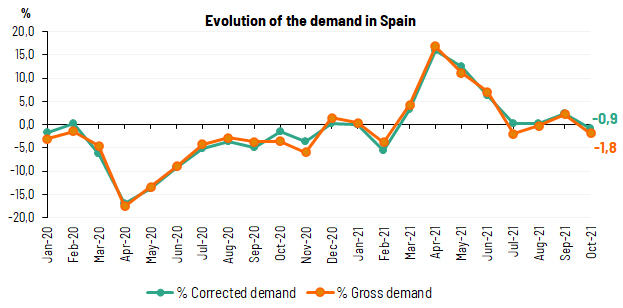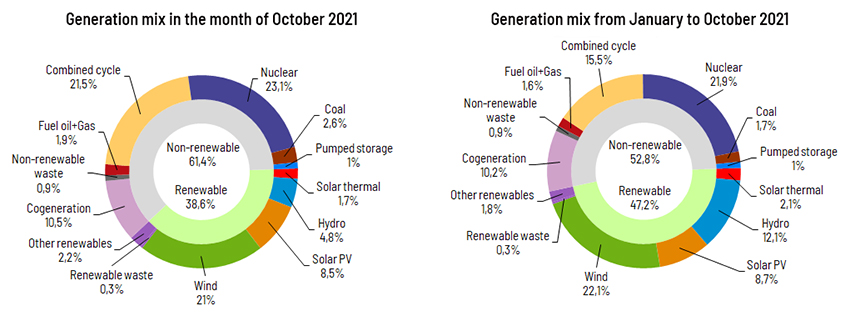For 40 years, we've been driving our country's economic and social progress. Four decades shaping Spain.
Demand for electricity in Spain falls 1.8% in October
- 38.6% of monthly generation came from renewable sources and 62.6% was obtained using technologies which produce zero CO2 equivalent emissions.
- Electricity demand grew by 21.1% in the Balearic Islands and 10.6% in the Canary Islands compared to October 2020.
National electricity demand in October is estimated at 20,298 GWh, a value that is 1.8% lower than the figure registered in the same month last year. After having factored in the influence of seasonal and working patterns, the figure is 0.9% lower than in October last year.

Compared to a pre-pandemic period (October 2019) and after having factored in the influence of seasonal and working patterns, national electricity demand registers a decrease of 2.4%.
In the first ten months of 2021, demand is estimated at 212,848 GWh, a figure that is 2.9% higher than in the same period in 2020. Once again, after having factored in the influence of seasonal and working patterns, demand stood at a value which is 3.1% higher than in the same period last year.
During October, and according to data estimated at the time of this press release, generation coming from renewable energy sources represented 38.6% of the generation mix nationwide. During the month, the production of green energy stood at 7,953 GWh, which represents a final value that is 18.9% lower than in October 2020.
With the information available at the time of this press release, solar photovoltaic generation in October totalled 1,762 GWh, a figure that is 34.2% more than in October 2020, and represented 8.5% of the total generation mix. For its part, wind power generation reached 4,328 GWh, 25% less than in the same month in 2020, mainly due to weather conditions. Thus, in October wind power accounted for 21% of the total production, making it the third largest contributor to the mix, surpassed only by nuclear (23.1%) and combined cycle, which produced 21.5%. So far this year (January-October), wind power has emerged as the leading technology in the generation mix, reaching 22.1% of total generation nationwide.
62.6% of electricity production in October was obtained using technologies which produce zero CO2 equivalent emissions (GHG emissions).

Demand for electrical energy in the peninsular electricity system fell 2.7%
Demand for electrical energy in the mainland electricity system in October is estimated at 19,072 GWh, down 2.7% compared to October 2020. After having factored in the influence of seasonal and working patterns, the demand for electricity is 1.7% lower than that registered in the same month last year.
Compared to a pre-pandemic period (October 2019) and after having factored in the influence of seasonal and working patterns, electricity demand on the peninsula registered a fall of 2.3%.
From January to October 2021, electricity demand on the Spanish mainland is estimated at 201,183 GWh, a value that is 2.8% higher than in the same period in 2020. In this case, after having factored in the influence of seasonal and working patterns, demand on the mainland registered a value that is 3% higher than last year.
During October, and according to data estimated at the time of this press release, 40% of electricity generation on the mainland came from renewable energy sources and 65.6% was obtained using technologies which produce zero CO2 equivalent emissions. For its part, wind energy stood at 4,204 GWh, 25.9% less than in October last year, and solar photovoltaic stood at 1,725 GWh, up 34.4% on the same month in 2020.
Demand for electricity in October increases 21.1% in the Balearic Islands and 10.6% in the Canary Islands
In the Balearic Islands, the demand for electricity in October is estimated at 445,440 MWh, a value that is 21.1% higher than that recorded in the same month last year. After factoring in the influence of seasonal and working patterns, the figure is 20.9% up on that recorded in October 2020.
Compared to a pre-pandemic period (October 2019) and after having factored in the influence of seasonal and working patterns, electricity demand on the Balearic Islands has fallen 6.8%.
In the first ten months of 2021, electricity demand in the Balearic Islands is estimated, in gross terms, at 4,683,405 MWh, a figure that shows an increase of 13.1% compared to same period in 2020.
Combined cycle, with 78.8% of the total production in the Balearic Islands, was the leading source of electricity generation in the archipelago in October, followed by off-grid diesel generators (9%). This month, renewable energy and those technologies which produce zero CO2 equivalent emissions accounted for 5.4% of the total mix on the Balearic Islands.
Furthermore, during the month, energy transferred via the Spanish Peninsula-Majorca submarine link contributed to covering 8.6% of the electricity demand in the Balearic Islands.
Regarding the Canary Islands, electricity demand is estimated at 745,958 MWh, up 10.6% on that recorded in October 2020. After factoring in the influence of seasonal and working patterns, the figure is 11.4% higher than that registered in the same month last year.
Compared to a pre-pandemic period (October 2019) and after having factored in the influence of seasonal and working patterns, the demand for electricity in the Canary Islands has registered a fall of 2.3%.
From January to October 2021, electricity demand in the Canary Islands is estimated, in gross terms, at 6,643,640 MWh, a figure that is 0.2% higher than in the same period in 2020.
In the Canary Islands, combined cycle, with a share of 40.6% of the total mix, was the leading source of electricity generation in October, while renewables and those technologies which produce zero CO2 emissions represented nearly 19.8% of the total generation.
Consult our Daily Balance Report for more information on the National, Peninsular, Balearic Islands and Canary Islands electricity systems as at the close of October.












